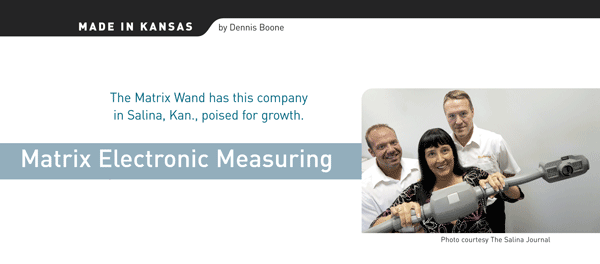

Think of a city where technology jobs are being created. San Jose may come to mind. Or Seattle. Maybe Austin, Raleigh-Durham or Orlando.
Salina, Kan., probably wasn’t high on your list.
But Jan Srack wants to change that.
The president and chief executive officer at Matrix Electronic Measuring, Srack and her team have just rolled out a product that they—and their investors—believe will revolutionize the collision-repair industry. It’s called the Matrix Wand, and it represents the next generation of products that have positioned her six-year-old company where no other has gone before.
“There is no competitive product out there,” Srack says. “This is not a commodity. It’s a unique, revolutionary tool. That’s one of the beauties of it.”
So what, exactly, is it? Think of it as a CAT scan for cars.
In laymen’s terms, the Wand functions like a three-dimensional camera, using a pair of 10-megapixel digital cameras in a process called photogrammetry. They sit about three feet apart on a plastic housing that weighs about three pounds.
If you do the math, that’s 100 million pixels of data within the cubic image produced by those cameras, and by computing the distance between various pixels, it’s possible to calculate with extreme precision the position of anything within that area, relative to anything else. Because of that, exact measurements can be drawn up to compare one section of car damage with measurements from an undamaged model, or even the undamaged opposite side of the vehicle.
That precision eliminates trial-and-error repairs at body shops, allowing technicians who have to fabricate or install replacement parts to do so more quickly and efficiently. The potential savings are apparent to any car-repair technician who’s had to hang a new door after straightening a frame jarred out of original alignment.
“In our industry, we have lacked electronic measuring,” Srack said, whose career has been spent in the collision-repair field. “As we were out in the shops as distributors over the past 25 years, we saw the need for a truly revolutionary piece of equipment that could save body shops time and bring money to the bottom line.”
And that was the vision for the Wand, which adds a powerful complement to the existing line of precision-measuring products for collision repair, which rely on lasers, infrared technology or charged-couple device cameras to perform measurements. The Wand, though, could be a breakthrough product that has such varied applications as crime-scene record-keeping, or potential medical uses, such as plotting exact skin reference points for dermatologists’ record-keeping and treatment.
Srack launched the company with her husband Bob; combined, they have 50 years of experience in the collision-repair industry. But to develop the Wand they needed to draw on the advice and talents of other business figures, university professors, engineers, scientists, software engineers and industry consultants.
It’s been a learning process that has taken her places she never envisioned from her background in the more traditional means of collision repair. “It’s never over,” she said of the need to expand her technological horizons. “It’s a straight-up learning curve.
“As with any revolutionary technology, there’s a lot of information that is hard-won,” she said. “Some that seems like it should be intuitive, it’s not. There are things you believe to be a fact that are actually anomalies, particularly with revolutionary product that nobody’s ever seen built.”
Srack gives particular credit to the Kansas Technology Enterprise Corporation and KTEC’s Pipeline program, which allowed Matrix to draw on expertise in engineering, software development, fabrication and more. That intellectual firepower has helped Matrix produce three different patents pending.
“The technology is being developed in Kansas. I absolutely love that idea,” Srack said. “Kansas has given a lot to its residents, and Matrix is looking forward to giving back to the state. We’re creating jobs in Kansas, we’ve saved jobs, and we hope to continue to do that.”